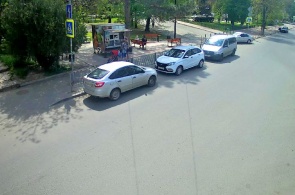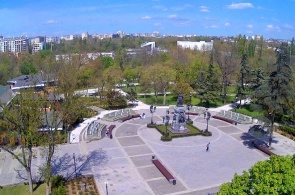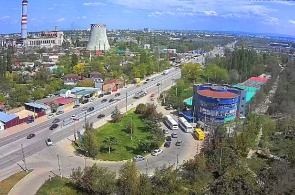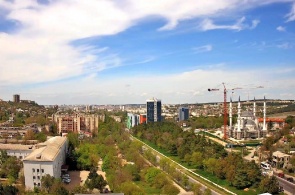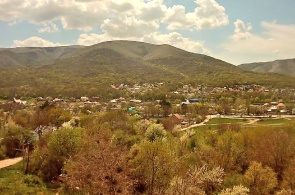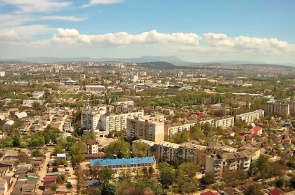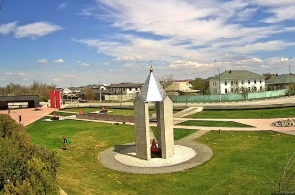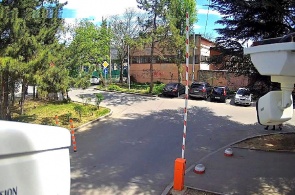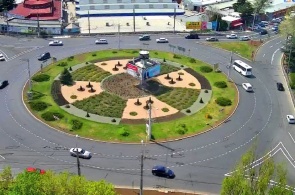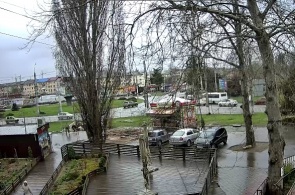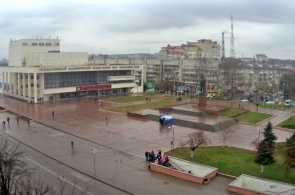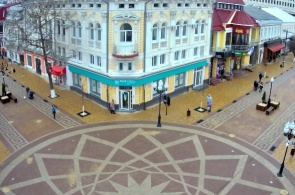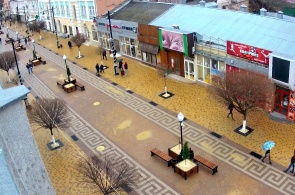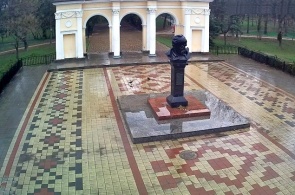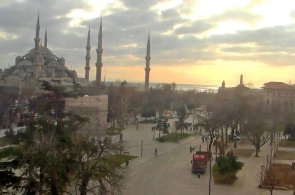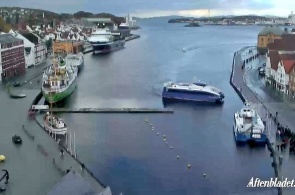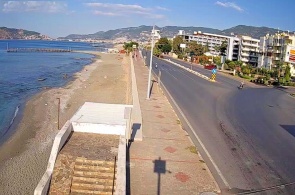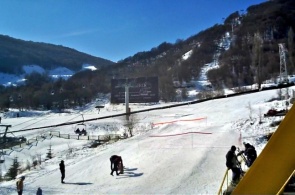Live webcam broadcasts in real time the stop "Cinema Zvezda" in Simferopol. On the site of modern Simferopol, the first people settled in the Paleolithic era, about 50 thousand years ago. On the left bank of the Salgir, in the Chokurcha cave, archaeologists discovered the site of the most ancient people. Here, in addition to primitive scrapers, knives and arrowheads, men and women sculptural portraits of striking craftsmanship were found, as well as images of animals and birds on bones and horns.
In the period from the III century BC. to the 3rd century A.D. on the site of Simferopol was the capital of the late Scythian state of Scythian Naples, and in the 15th-18th centuries there was a large Tatar settlement Ak-Mechet. By medieval standards, Ak-Mosque was a fairly large city. It was home to about 10 thousand people. Houses in the city were mainly two- and three-story, there were many mosques, bazaars, hotels. Picturesque fountains were the decoration of the city.
After the annexation of Crimea to Russia, it was planned to make the city of Old Crimea the administrative center of the peninsula. However, Empress Catherine II ordered to build a new capital of the peninsula next to the medieval Ak-Mosque. On February 19, 1784, a decree was issued on the founding of a new city. Simferopol owes its name to Evgeny Bulgaris, a well-known spiritual and secular figure, a famous scientist. The name of the city from Greek can be translated as "city of benefit", "city-gathering"
The city was built by the forces of soldiers and state peasants who were dismissed from service, brought here from the central provinces and from Little Russia. Hewn stone from the ruins of Scythian Naples was used as a building material for administrative and residential buildings.
Simferopol developed rather quickly, but after Emperor Paul I abolished the Tauride region, the construction of the city was suspended, and revived again only after the accession of Alexander I and the assignment of Simferopol the status of the main city of the Tauride province.
During the Crimean War of 1853-1856, all the main rear services of the Russian army were concentrated in Simferopol. The units that went to reinforce the Sevastopol garrison were equipped here. The city was turned into a huge hospital: thousands of wounded defenders of Sevastopol were brought here.
The life of the provincial town became more lively when, in 1874, the construction of the Kharkov-Simferopol railway was completed. The first industrial enterprises appeared in the city - canning, confectionery, tobacco factories.
With the establishment of Soviet power in the Crimea, Simferopol became the capital of the Crimean Autonomous Soviet Socialist Republic. In the 1920s and 1930s, many industrial enterprises appeared in the city. Simferopol is becoming an important scientific center. During the Great Patriotic War, Simferopol was subjected to massive bombing, as a result of which the architectural appearance of the city was irreparably damaged. After the war, the city was rebuilt at an accelerated pace. New houses, factories appeared, the transport system was reconstructed. Today the city continues to develop actively.
In the period from the III century BC. to the 3rd century A.D. on the site of Simferopol was the capital of the late Scythian state of Scythian Naples, and in the 15th-18th centuries there was a large Tatar settlement Ak-Mechet. By medieval standards, Ak-Mosque was a fairly large city. It was home to about 10 thousand people. Houses in the city were mainly two- and three-story, there were many mosques, bazaars, hotels. Picturesque fountains were the decoration of the city.
After the annexation of Crimea to Russia, it was planned to make the city of Old Crimea the administrative center of the peninsula. However, Empress Catherine II ordered to build a new capital of the peninsula next to the medieval Ak-Mosque. On February 19, 1784, a decree was issued on the founding of a new city. Simferopol owes its name to Evgeny Bulgaris, a well-known spiritual and secular figure, a famous scientist. The name of the city from Greek can be translated as "city of benefit", "city-gathering"
The city was built by the forces of soldiers and state peasants who were dismissed from service, brought here from the central provinces and from Little Russia. Hewn stone from the ruins of Scythian Naples was used as a building material for administrative and residential buildings.
Simferopol developed rather quickly, but after Emperor Paul I abolished the Tauride region, the construction of the city was suspended, and revived again only after the accession of Alexander I and the assignment of Simferopol the status of the main city of the Tauride province.
During the Crimean War of 1853-1856, all the main rear services of the Russian army were concentrated in Simferopol. The units that went to reinforce the Sevastopol garrison were equipped here. The city was turned into a huge hospital: thousands of wounded defenders of Sevastopol were brought here.
The life of the provincial town became more lively when, in 1874, the construction of the Kharkov-Simferopol railway was completed. The first industrial enterprises appeared in the city - canning, confectionery, tobacco factories.
With the establishment of Soviet power in the Crimea, Simferopol became the capital of the Crimean Autonomous Soviet Socialist Republic. In the 1920s and 1930s, many industrial enterprises appeared in the city. Simferopol is becoming an important scientific center. During the Great Patriotic War, Simferopol was subjected to massive bombing, as a result of which the architectural appearance of the city was irreparably damaged. After the war, the city was rebuilt at an accelerated pace. New houses, factories appeared, the transport system was reconstructed. Today the city continues to develop actively.
More details
Live webcam broadcasts in real time Mendeleev Street, in the capital of Crimea - Simferopol. In March 1904, this then new street, which arose on the so-called Sultan Meadow, was named Mendeleevskaya. The Duma and the government could not ignore the giant of scientific thought, the creator of the periodic table of elements. Moreover, the great chemist began his career in Simferopol.
Simferopol, Crimea
03.07.21
Live webcam in the Catherine Park of Simferopol, in the foreshortening of this webcam, we can observe the monument to Catherine II. The Catherine Garden is the oldest public park in Simferopol. The first trees were planted on the banks of the Salgir back in 1820, and immediately the magnificent English-style park became a favorite walking place for the townspeople.
Simferopol, Crimea
03.07.21
Live webcam broadcasts in real time a panoramic view of the village of Gresovsky located 8 km from Simferopol on the banks of the Salgir River. Founded on the site of the former village of Zamosc. Among Simferopol residents it is known as the state district power station.
Simferopol, Crimea
27.06.21
Live webcam broadcasts in real time the largest mosque in Crimea - the Cathedral Mosque in Simferopol. Today Kebir-Jami is the main Friday cathedral mosque in Simferopol, the residence of the mufti and the Spiritual Administration of Muslims of Crimea. The complex includes a madrasah (educational institution) and a library.
Simferopol, Crimea
27.06.21
The web camera online broadcasts in real time the village of Perevalny, a view of the mountains. The village of Perevalny is located on the Simferopol-Yalta highway, 24 km from Simferopol at the northern foot of the Chatyr-Dag massif. The first name of the village of Angara, in 1945 renamed the Pereval. The first mention dates back to 1864 as a tavern on the river Angara, under the same name.
Simferopol, Crimea
12.06.21
The web camera online broadcasts in real time one of the favorite observation decks of Simferopol residents on the street of Marshal Shchukov. Simferopol is the second largest city in Crimea. It stands on the Salgir River away from the Black Sea coast, so it is impossible to call Simferopol a resort in its purest form. However, there are enough attractions to fill the schedule of any tourist under the knot.
Simferopol, Crimea
12.06.21
Live webcam broadcasts in real time a memorial to the victims of the Nazi occupation of Crimea in 1941-1944 "Red concentration camp". "Krasny" is a state farm near Simferopol, on the territory of which the German-fascist occupation authorities, with the complicity of collaborationists from the local population, organized the largest death camp in Crimea in September 1941.
Simferopol, Crimea
09.05.21
Live webcam broadcasts in real time Rostovskaya Street in Simferopol. Simferopol is the capital of Crimea. The name is translated from Greek as "city of the common good" or "guardian city". It is located not on the sea coast, but in the depths of the peninsula. However, this does not take away its charm.
Simferopol, Crimea
08.05.21
Live webcam overlooking Liza Chaikina Street in Simferopol. Elizaveta Ivanovna Chaikina - secretary of the Penovsky underground district committee of the Komsomol of the Kalinin region, one of the organizers of the partisan detachment during the Great Patriotic War. Hero of the Soviet Union. Liza was shot by the Nazis on November 23, 1941. Streets in many cities of Russia and the CIS countries are named after her.
Simferopol, Crimea
08.05.21
Live webcam in Simferopol, overlooking Moscow Square. Along the ring of Moskovskaya square you can go to Kievskaya and Kechkemetskaya streets. Initially, the street was called Perekopskaya, after an active period of development in the 60s of the last century, it was renamed in honor of the great Soviet cosmonaut into Gagarin Street.
Simferopol, Crimea
08.05.21
Web camera in Simferopol, Kirov Avenue with views of the main square of city - Lenin square.
Simferopol, Crimea
02.04.17
Webcam at the intersection of Central streets of Simferopol - Karl Marx and Pushkin.
Simferopol, Crimea
02.04.17
The web camera installed on the pedestrian area of Catherine street (former Karla Marksa) in Simferopol.
Simferopol, Crimea
26.03.17
popular camerasshow all
Sultanahmet or Blue mosque is a work of art of Turkish-Islamic architecture. Its construction began in 1609, the construction work took seven years to a 19-year-old Sultan. The name of the mosque was, due to its interesting and unique finish.
Istanbul, Turkey
Stavanger, a town in the commune of Norway, located in the South-Western part of the country, on the Peninsula, rich in minerals. Tanager combines the influence of foreign organisations such as NATO and oil companies. The camera will shoot the harbour and the promenade of the city.
Stavanger, Norway
A webcam broadcasts the district of Tosmur - quiet location in the Eastern part of Alanya, located only five kilometres from the city centre. Its rural way of life and the beauty of untouched nature attract tourists.
Alanya, Turkey
Shark Island or in English of Shark island, located in the harbour city of Sydney, the suburb of Point Piper. The locals, the natives named the island Boambilly, which translated means Shark island. After all, this name is not casual, because it's mean and looks like a shark fin.
Sydney, Australia
The webcam is installed on site Alva. Tsaghkadzor ski resort town in Armenia. Tsaghkadzor is a beautiful mountainous area among deciduous forests, with a pleasant winter climate, and clean fresh air. The highest point is 1800 meters. The truss type is a classic, divided into three.
Tsakhkadzor, Armenia

